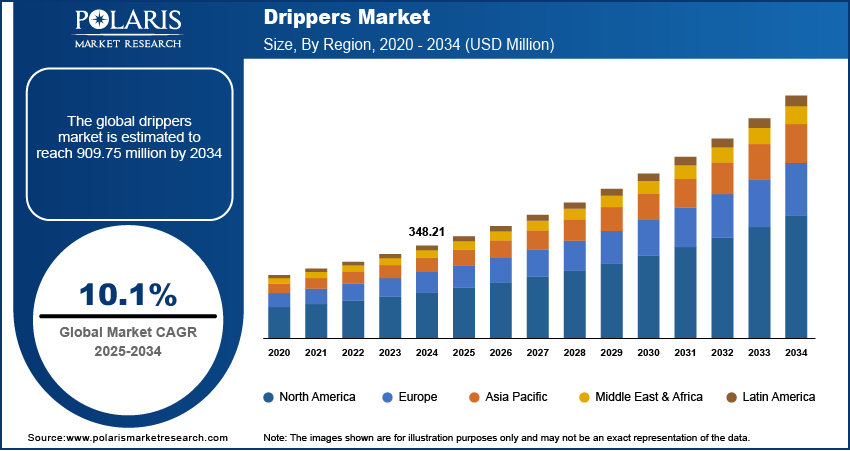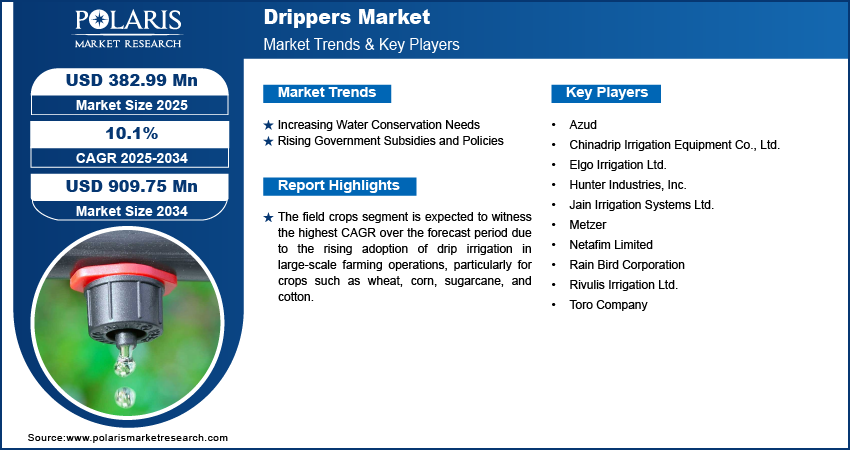
Drippers Market Share, Size, Trends, Industry Analysis Report, By Emitters Type (Inline and Online); By Application; By Crop Type; By Components; By Region; Segment Forecast, 2023 - 2032
- Published Date:Jun-2023
- Pages: 119
- Format: PDF
- Report ID: PM3395
- Base Year: 2022
- Historical Data: 2019-2021
Report Outlook
The global drippers market was valued at USD 286.24 million and is expected to grow at a CAGR of 11.39% during the forecast period. Population growth, declining water waste, technological advancements in irrigation systems, and government subsidies in various nations are all driving up demand for agricultural products such as drippers. Using valves, piping, and tubing, drip irrigation systems enable water to trickle near plant roots. These methods reduce water waste. Farmers choose this technology as well since surface irrigation wastes water through evaporation. Therefore, the market is expanding due to the increasing use of drippers.

To Understand More About this Research: Request a Free Sample Report
Drippers are a kind of watering tool that uses water in agricultural areas in a controlled and advantageous way for the environment. Drip Irrigation Emitters, sometimes known as "drippers," are tools used to regulate the amount and velocity of water flowing from the tubing to the plants. Without these devices, plants with low water need to risk drowning, suffering root damage, and the soil flooded. An agricultural dripper is used to manage the issue. When watering crops, the dripper is a fantastic way to conserve as much water as possible.
Additionally, they use a great deal less water than the standard method while still making sure the plants are taken care of and appropriately hydrated, which could be the reason the drippers market for agriculture drippers is growing so quickly. Drippers saved the day because irrigation water is scarce in many countries. Because it is more resourceful and conserves water while minimizing soil erosion, farmers and the general public favor it.
The manufacturers in the market are using various strategies for the development of the market such as product development, mergers and acquisition, collaborations, and investments among others. In March 2022, To support farmers all across the world, PepsiCo and N-Drip launched their collaboration. By 2025, 10,000 hectares (25,000 acres) will embrace ground-breaking water efficiency technology. Numerous farmers utilize flood irrigation, also known as trench irrigation, to supply their crops with water. This method periodically floods the area, wasting up to 70% of the water applied. Even in areas with limited water supplies, this method is still used on 85% of the world's irrigated crops or about 600 million acres.
To stop the spread of the COVID-19 sickness, numerous countries around the world have enacted a nationwide lockdown. There is a labor shortage at the factories that make drip irrigation systems as a result of the lockdown. Manufacturing facilities have difficulty moving the products because of the lack of labor. Additionally, manufacturers are unable to convey their goods since there aren't enough transportation options, such as trains and heavy-duty vehicles. The COVID-19 epidemic restricted the market expansion for dripper systems as a result of all the previously mentioned causes.

For Specific Research Requirements, Speak to Research Analyst
Industry Dynamics
Growth Drivers
The prospects for drippers in the Asia Pacific region continue to be improved by government initiatives, subsidies, and industry involvement. Governments across the nations are focusing on the launches of schemes that are supporting the purchasing of drippers as well as drip irrigation systems. For instance, the Indian Government launched a scheme for Indians named “Micro Irrigation Subsidy”. Farmers in India can afford micro irrigation systems due to subsidies (financial assistance) provided by the government. The Pradhan Mantri Krushi Sinchay Yojna (PMKSY), which was introduced in 2015, provides the subsidy. The subsidy lets farmers adopt micro-irrigation systems at a lower initial cost, which increases their incomes. The PMKSY program offers irrigation subsidies for both drippers and sprinkler systems. This program offers loan support to states so they can speed up the execution of irrigation projects by completing large or medium-sized irrigation projects that were in a more advanced stage of completion.
Furthermore, in February 2022, Under the Per Drop More Crop program, the Central Government offers financial assistance to farmers at a rate of 55 percent of the suggested unit cost and to other cultivators at a rate of 45 percent to encourage them to construct drip and sprinkler irrigation systems. This will increase coverage. The Pradhan Mantri Krishi Sinchayee Yojana (PMKSY), which was introduced on July 1 under the slogan "Har Khet Ko Paani," is being used to increase the area that may be planted with guaranteed irrigation, decrease water waste, and increase water usage effectiveness. This assistance from the government for purchasing dripper equipment as well as for irrigation activities is driving the growth of the market over the forecast period.
Report Segmentation
The market is primarily segmented based on emitters type, crop type, application, components, and region.
|
By Emitters Type |
By Crop Type |
By Application |
By Components |
By Region |
|
|
|
|
|
To Understand the Scope of this Report: Speak to Analyst
The inline drippers segment is expected to witness the fastest growth during forecast period
Low-density polyethylene is linear and is used to create inline drippers. Since inline emitters are primarily self-flushing, they help to maximize resistance to clogging. Both subsurface irrigation and surface irrigation are appropriate for inline emitters. To minimize connections with a simple pipe in potential irrigation-free zones, inline drippers are best suited for plants that are equally spaced. Dripper insertion is done during the extrusion process, making inline drippers easy to install and reliable as soon as one end of the pipe is connected to a water supply.
The greenhouses application segment industry accounted for the highest market share in 2022
The segment is holding the highest market share due to drippers using a major product from this application. Government agencies are focusing on the development of projects for the growth of the greenhouse that is driving the market over the forecast period. In March 2022, The National Agriculture Research Centre (NARC), a partner in the PROSIM project, published an invitation for bids on March 20, 2022, for the installation of drip irrigation systems in greenhouses and open fields in Balqa, Jordan. A total of 35 farmers will use the equipment, which will cover 15.5 hectares. Additionally, controlling soil moisture requires automatic drip irrigation.
The field Crops segment is expected to hold the significant revenue share during forecast period
Drippers have grown in significance for growers of field crops due to their precise application to the crops. One of the most important crops farmed globally is cotton, where drip irrigation systems are being introduced quickly. With the use of drippers, yields can double while real water use is reduced by half. Cotton can be irrigated with as little as 4mm per day on average if the water application technique is accurate and consistent. To achieve this drip, deploy high-quality drip systems with the appropriate drippers.
Increasing cotton productivity mostly depends on managing irrigation water and soil fertility. It is difficult to maintain constant moisture levels in cotton fields. It might promote the spread of illness and pests. In this situation, drip irrigation is the best choice because it maintains steady moisture levels. Additionally, cotton farming has issues with blooming, ball development, and ball opening. Due to these qualities, balanced nutrition, a 95% germination rate, and other criteria, as well as the close spacing of cotton plantations, drip irrigation are essential for cotton production.
The demand in Asia-Pacific is expected to witness significant growth during study period
The Asia Pacific region, which accounted for the biggest proportion throughout the projection period, is expected to lead the market for drippers globally. Due to the region's growing levels of water shortage, developing nations like India and China are among the biggest customers. The Asia Pacific area's huge number of farmers is the main factor driving the market growth in this region. In nations like India, agriculture still provides the main means of subsistence for the majority of the population.
Drip irrigation systems are getting cheaper for farmers with medium-sized farms because of the rising government support in the form of subsidies. The market for local drippers is therefore expanding as a result. Further fueling the market's expansion is the growing focus on cash crops. To fuel market expansion, the major manufacturers are also introducing new items. In October 2022, a new tool has been released by Rivulis India to help Indian farmers make judgments regarding the need for irrigation in their farms. Farmers in India have access to this technology in their languages.
Competitive Insight
Some of the major players operating in the global market include Azud Corp., Antelco, Agrodrip, Chinadrip Irrigation Equipment, DripWorks, Elgo Irrigation, Grupo Chamartin, Hunter Industries, Irritec, Jain Irrigation, KSNM Drip, Novedades Agrícolas., Netafim Limited, Raindrip, Rain Bird Corporation, Rivulis Irrigation, and Toro Company.
Recent Developments
- In February 2022, Toro Company announced the addition of Aqua-Traxx Azul to its existing Azul range with improved features like lower filtration requirements, ultra-low flow emitters to provide control over water infiltration and less clogging concerns.
- In August 2021, Netafim introduced new portable drip kit. The kit provides installation assistance without the need for additional work and is specifically suited for small farmers with fields of up to one acre. Through Netafim's dealer network, the portable drip kit is accessible throughout all of India. It is ideal for all forms of Rabi & Kharif crops, including vegetables, crops with close spacing, & other crops.
Drippers Market Report Scope
|
Report Attributes |
Details |
|
Market size value in 2023 |
USD 306.11 million |
|
Revenue Forecast in 2032 |
USD 808.43 million |
|
CAGR |
11.39% from 2023 - 2032 |
|
Base year |
2022 |
|
Historical data |
2019- 2021 |
|
Forecast period |
2023- 2032 |
|
Quantitative units |
Revenue in USD million and CAGR from 2023 - 2032 |
|
Segments Covered |
By Emitters Type, By Crop Type, By Application, By Components, By Region |
|
Regional scope |
North America, Europe, Asia Pacific, Latin America; Middle East & Africa |
|
Key Companies |
Azud Corp., Antelco Pty Ltd., Agrodrip S.A., Chinadrip Irrigation Equipment Co. Ltd., DripWorks Inc., Elgo Irrigation Ltd., Grupo Chamartin S.A., Hunter Industries, Inc., Irritec S.p.A, Jain Irrigation Systems Ltd., KSNM Drip Ltd., Novedades Agrícolas S.A., Netafim Limited, Raindrip, Inc., Rain Bird Corporation, Rivulis Irrigation Ltd., and The Toro Company |
FAQ's
The global drippers market size is expected to reach USD 808.43 million by 2032.
Key players market players in the drippers market are emitters type, crop type, application, components, and region.
Asia-Pacific contribute notably towards the global drippers market.
The global drippers market expected to grow at a CAGR of 11.39% during the forecast period.
The drippers market report covering key segments are emitters type, crop type, application, components, and region.
